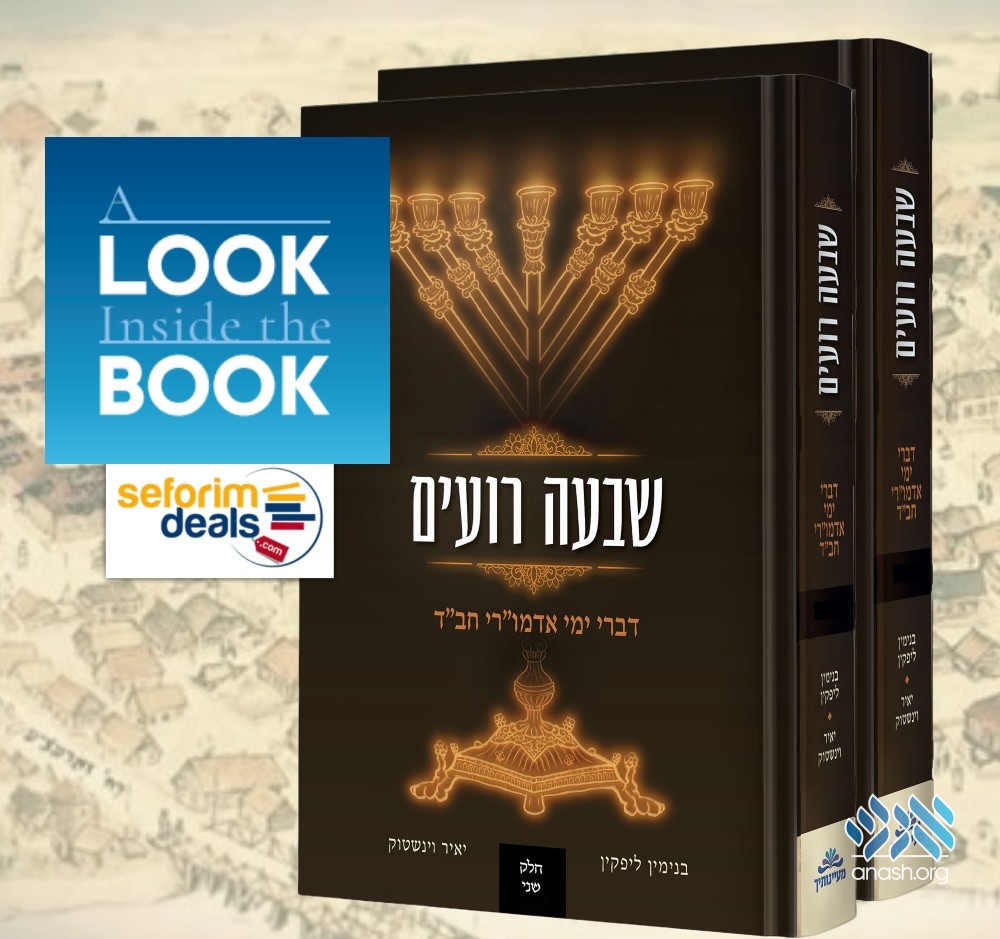י״ט שבט ה׳תשפ״ב | January 20, 2022
A Biography of Our Rebbes Like Never Seen Before
A wealth of information is available about the history of Chabad and its Rebbes. Yet, a proper biography of all seven Rebbes was noticeably missing. A new 2-volume series sets out to fill that gap, offering full biographies in an enjoyable fashion.

A wealth of information is available about the history of Chabad and its Rebbes. Yet, a proper biography of all seven Rebbes was noticeably missing. A new 2-volume series sets out to fill that gap, offering full biographies in an enjoyable fashion.
A Look Inside the Book is an Anash.org feature that takes a look at what’s new on the shelves of Seforim stores, and reviews recently printed seforim and books. The feature is sponsored by SeforimDeals.com
By Shmuel Super
Shivah Ro’im
Binyamin Lipkin and Yair Weinstock
Maayanotecha, 5782
Vol. 1: 414 pages, Vol. 2: 447 pages
Introduction
A wealth of information is available about the history of Chabad and its Rebbes. This includes the Igros of the Rebbeim themselves, the sichos and writings of the Frierdiker Rebbe, many books of sipurei Chassidim, and history books focusing on specific events and periods.
Yet, surprisingly, something had still been missing until now: a readable and accessible work including the biographies of all seven Rebbes. The acclaimed Beis Rebbe, written almost 120 years ago by R. Chaim Meir Hillman, does this, but only for the first three Rebbes of Chabad.
Sefer Hatoldos, edited by R. Chanoch Glitzenshtein, covers the nesi’im from the Baal Shem Tov until the Frierdiker Rebbe. But a number of issues stand in the way of the reader of this series who is looking for a concise history of the Rebbeim.
Firstly, the incredible length of the series, spanning 14 volumes. This issue was addressed a few years ago with the publication of Toldos Raboseinu Nesi’einu, a single volume containing selected excerpts from the Sefer Hatoldos set.
But other issues still remain. The Sefer Hatoldos series draws solely from the writings of the Frierdiker Rebbe. While this lends the advantage of superior authority, sipurei Chassidim and other historical sources are needed in order to provide a complete biography. In addition, Sefer Hatoldos contains only very lightly edited selections from the writings of the Frierdiker Rebbe arranged in a chronological order, and does not weave them together into a cohesive narrative. And, of course, Sefer Hatoldos contains no biography of our Rebbe.
Shivah Ro’im, a new two volume set published by Maayonotecha, aims to fill this gap. The first volume covers the Alter Rebbe, Mitteler Rebbe, Tzemach Tzedek and Rebbe Maharash, and the second volume relates the biographies of the Rebbe Rashab, the Frierdiker Rebbe, and the Rebbe.
In this review, we will explore the methodology of these books and briefly describe their contents.
Methodology
Shivah Ro’im is written by Binyamin Lipkin, an experienced Lubavitcher author, and the editor of the Hamevaser newspaper in Eretz Yisrael. In writing this work, Lipkin was assisted by Yair Weinstock. Perhaps better known in the English speaking world for his novels, Weinstock’s original and primary field of expertise is in writing stories and biographies of tzadikim.
The stated goal of Shivah Ro’im is to make the history of the Rebbeim clear and accessible to the broader frum public interested in learning more about Chabad. Of course, Lubavitchers—and especially younger readers—will also enjoy this concise overview of the Rebbeim’s lives and activities.
Our authors do not intend to innovate in these books, neither with new information or fresh analysis. Instead, they aim to take the already available material and fashion it into a clear and concise narrative.
The books are written in an engaging style that captures some of the feeling and spirit of the time, drawing the reader into the story. The style is flowery and rabbinic, and the tone is reverent, expressing and inspiring awe and respect for the Rebbeim.
The primary source used is the Frierdiker Rebbe’s writings, as collected in Sefer Hatoldos. This serves as the backbone of the books, and it is supplemented by stories from Beis Rebbe and the books of sipurei Chassidim written by the Chassidim of the previous generation.
Our authors have made an editorial decision to almost completely exclude external sources, from non-Chasidim. Some of these outsider accounts contain very rich and detailed descriptions of the Rebbeim and their chatzer that could have significantly enhanced the books.
For example, excerpts from Shmuel Yosef Fuenn’s fascinating account of the Tzemach Tzedek’s 5595 visit to Vilna, including a description of the delivery of a maamar and yechidus (See Heichal Habaal Shem Tov 15, pp. 135-140), would have enhanced the section about the Tzemach Tzedek.
Commendably, despite their goal of producing a popular work, the authors did not compromise on professionalism, and meticulously footnote the source for practically every detail.
Content
To give a taste of the content of the book, we will take the first—and largest—part of the books, the section devoted to the Alter Rebbe. The first chapter relates the wondrous story of the Alter Rebbe’s birth and the Baal Shem Tov’s involvement with this. We go on to read about the Alter Rebbe’s youth as a child prodigy, his marriage to Rebbetzin Shterna, and his becoming a chassid of the Magid of Mezeritch.
Then the book turns to the Alter Rebbe’s works and thought. One chapter relates the story of the writing of the Shulchan Aruch on the Magid’s instructions, and other chapters introduce us to the Alter Rebbe’s shitah of Chabad; the Tanya; tefilah in the life and thought of the Alter Rebbe; and the role of neginah.
As this work is intended to serve as a light biographical read, the topics of Halachic method and Chassidic thought are described primarily through the story of their development, rather than attempting to plumb the depths of their content. But we are given some basic points regarding the uniqueness of the Alter Rebbe’s Shulchan Aruch, drawn from an essay by Harav Shlomo Yosef Zevin, and some elaboration on the Tanya, from R. Adin Steinsaltz.
This is true of the other sections about the other Rebbeim as well. The story of the Rebbe Rashab’s famous hemsech of samech vov includes some observations of R. Zalman Gopin, and the chapter about the Rebbe’s Torah incorporates excerpts from the introduction to Otzar Likutei Sichos, highlighting key features of the Rebbe’s approach.
Returning to the Alter Rebbe’s biography, in the story of his imprisonment and release, excellent use is made of the Alter Rebbe’s handwritten response to the questions of his interrogators (though curiously, the point of this episode reflecting a divine kitrug and vindication aren’t emphasized in this chapter). The section concludes with the story of the Alter Rebbe’s deep involvement in the Napoleonic war and histalkus.
As the work is geared towards the broader frum public, emphasis is placed throughout the set on the Rebbeim’s relationships with their contemporary gedolei Yisrael. Matters of machlokes leshem shamayim, such as the disagreement between the Alter Rebbe and Harav Avraham Kalisker, and the split between the Mitteler Rebbe and Harav Aharon of Strashele are acknowledged, but not discussed in any detail.
One element that may have enhanced the biographies is including brief biographical information about each Rebbe’s most prominent talmidim, as the author of Beis Rebbe did. Figures such as Reb Aizel Homiler, Reb Hillel Paritcher, Reb Shmuel Ber Borisover, and Radatz Chein are integral parts of Chabad histories. These names come up repeatedly in stories in the books, and readers seeking to learn about the Rebbeim would be interested in learning a little about the great chassidim they shaped.
The chapters about the Rebbe Rashab’s activism on behalf of Russian Jewry (chapter 5); the Frierdiker Rebbe’s mesiras nefesh work preserving Yiddishkeit under the Soviets (chapter 4); and the Frierdiker Rebbe’s visit to Eretz Yisrael and the U.S. (chapter 6) are worthy of special mention. These chapters present clear overviews of episodes of Chabad history that are well known, but are often not properly understood and appreciated in their historical context.
Conclusion
Shivah Ro’im is a clear and concise overview of the seven Rebbeim of Lubavitch that will be enjoyed by a range of readers, from non-Lubavitchers seeking an introduction to Chabad, to Lubavitcher readers looking to enhance their knowledge of the Rebbeim’s history.
Volume one of Shivah Ro’im can be purchased here, and volume two can be purchased here.
A Look Inside the Book is sponsored by SeforimDeals.com. Contents of the article are prepared by the author.
For previous articles in the series, click here.


We appreciate your feedback. If you have any additional information to contribute to this article, it will be added below.